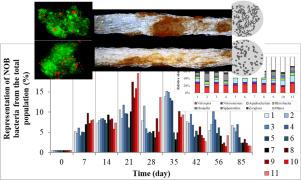Environmental Technology & Innovation ( IF 7.1 ) Pub Date : 2021-01-13 , DOI: 10.1016/j.eti.2021.101373 Lucie Svobodová , Karel Havlíček , Magda Nechanická , Roman Špánek , Brigita Kolčavová Sirková , Irena Lenfeldová , Ondřej Louda , Eva Moučková , Tomáš Lederer

|
Ammonia nitrogen in water negatively impacts aquatic life. Nitrifying bacteria are slow-growing and sensitive microorganisms, and technology using biofilm is an attractive option for their support. This study aims to demonstrate an optimal structure for microfilament carriers for growth of nitrifying bacteria in the tertiary stage of wastewater treatment (post-nitrification). Eleven samples of three polymer types (polyester, polypropylene, polyamide) that display different numbers of fibrils, fibril diameters, and structures were chosen for testing. Biofilm growth was monitored weekly using total protein concentrations and optical and fluorescence microscopy aided by image analysis. Final samples were characterized using molecular biological analysis (quantitative polymerase chain reaction and next-generation sequencing). Contents of ammonia-oxidizing bacteria (AOB) were significantly (four- to five-fold) lower than those of nitrite-oxidizing bacteria (NOB) in all tested samples. The relative abundance of NOB dominant strain, Nitrospira, reached >20%, whereas the abundance of Nitrosomonas, the only AOB representative, ranged between 3% and 6%. Polyester material was identified as optimal for support of nitrifying bacteria. This material displays maximum numbers of multifilament fibrils, and diameters of fibril and interspaces were minimal. These parameters play a crucial role for immobilization of nitrifying bacteria.
中文翻译:

用于增强硝化细菌在硝化后反应器中的固定化的超细纤维结构
水中的氨氮会对水生生物产生负面影响。硝化细菌是生长缓慢且敏感的微生物,使用生物膜的技术是支持它们的诱人选择。这项研究旨在证明在废水处理的第三阶段(硝化后)中用于硝化细菌生长的微丝载体的最佳结构。选择了三种聚合物类型(聚酯,聚丙烯,聚酰胺)的11个样品,这些样品显示出不同的原纤维数量,原纤维直径和结构,以进行测试。每周使用总蛋白浓度和图像分析辅助的光学和荧光显微镜监测生物膜的生长。使用分子生物学分析(定量聚合酶链反应和下一代测序)对最终样品进行表征。在所有测试样品中,氨氧化细菌(AOB)的含量均显着低于亚硝酸盐氧化细菌(NOB)的四至五倍。NOB优势菌株的相对丰度,Nitrospira达到> 20%,而唯一的AOB代表Nitrosomonas的丰度在3%到6%之间。聚酯材料被认为是支持硝化细菌的最佳材料。该材料显示出最大数量的复丝原纤维,并且原纤维和间隙的直径最小。这些参数对于硝化细菌的固定起着至关重要的作用。



























 京公网安备 11010802027423号
京公网安备 11010802027423号